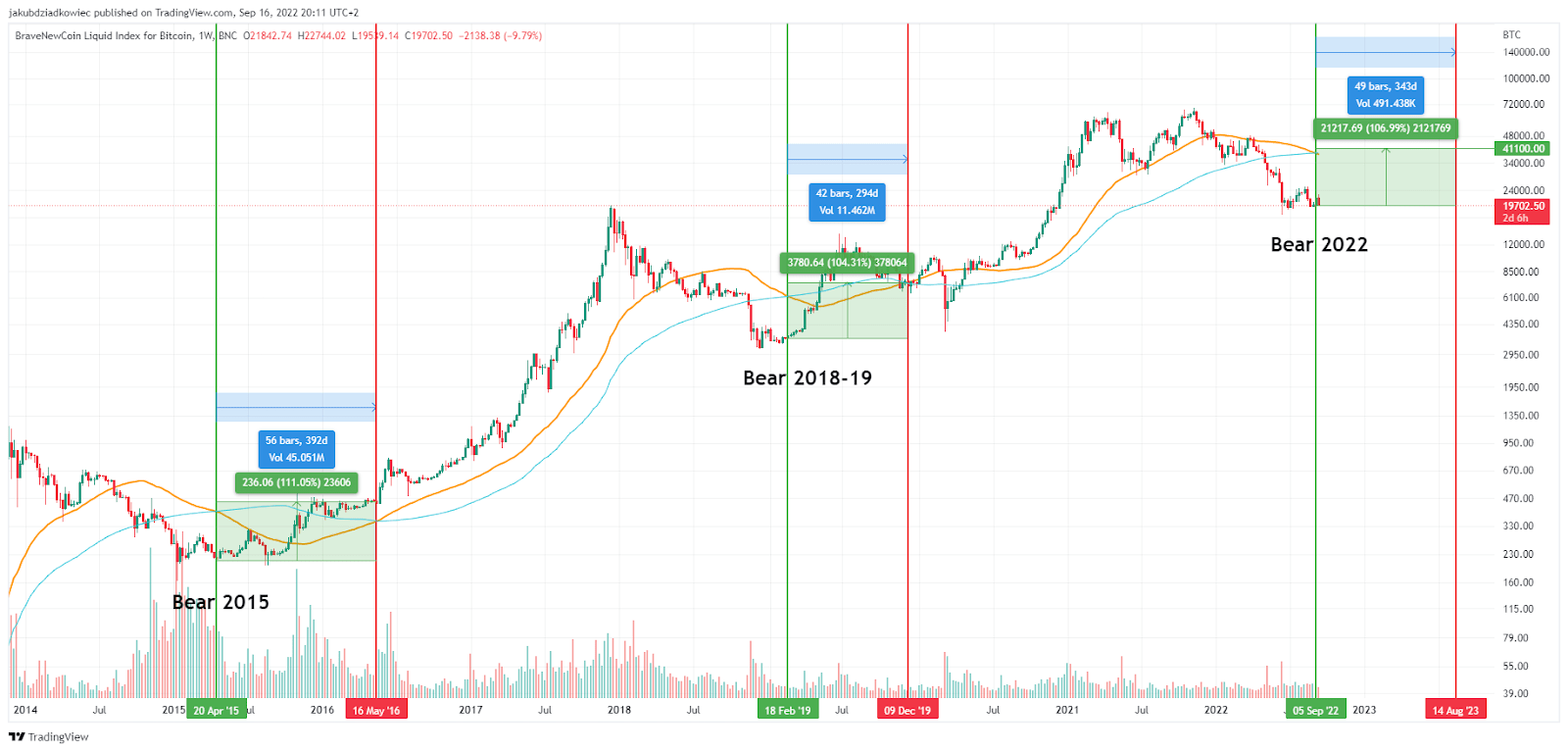Bitcoin (BTC) Gets Third-Ever Bullish Signal From These Two Moving Averages

For the third time in history, two important moving averages made a bearish intersection on the Bitcoin (BTC) chart. Paradoxically, this could be a very bullish signal! Historically, it has led to large increases and initiated an accumulation phase before the next bull market.
Long-term moving averages like to stay away from each other. However, from time to time they intersect, often defining turning points on the chart of an asset. On Bitcoin’s chart, the 50-week and 100-week moving averages (50W MA and 100W MA) serve such a function.
In today’s analysis, we will look at their historical intersections, which gave interesting long-term signals for the BTC price. This is because it turns out that a bearish cross was a signal of reaching a bottom in historical bear markets. A bullish cross, on the other hand, gave reason to start another bull market.
In confluence with these two moving averages is the so-called Coral Trend Indicator. This indicator also signals that the bottom of the current bear market has already been reached, and Bitcoin is currently undergoing an accumulation phase before the next bull market.
50W MA crosses 100W MA
On August 5, an important technical event occurred on the BTC chart. Two important moving averages made a bearish cross. The 50W MA fell below the 100W MA. This was the 3rd such situation in the entire history of BTC trading (green lines).

Chart by Tradingview
Previously, this signal appeared twice: on April 20, 2015, and on February 18, 2019. In both cases, the intersection occurred a dozen weeks after Bitcoin reached the absolute bottom of the bear market. The same is true this time:
- 2015: 14 weeks / 98 days from the bottom at $164
- 2019: 10 weeks / 70 days from the bottom at $3,148
- 2022: 12 weeks / 84 days from the bottom at $17,607
Thus, it turns out that the intersection that took place on September 5 is perfectly in the middle of the time range set by the two previous historical signals. Of course, two historical signals are far too few to be statistically valid. However, one can certainly speak of some similarities.
Bitcoin at $41,100 on August 14, 2023
Looking further at this signal, one can trace what happened next. The next major event was a bullish cross when the 50W MA returned above the 100W MA. This has happened twice so far: on May 16, 2016, and on December 9, 2019 (red lines).
After the week in which the bearish cross occurred, the BTC price went through a phase of accumulation and increase. From 2015-2016, it surged by 111% during this period, while in 2019 it increased by 104%. Meanwhile, the time separating the two signals was 56 and 42 weeks, respectively.

Chart by Tradingview
Now, if we would like to extrapolate this scant data to the current chart, we can attempt to calculate the price of BTC and the time it will reach the next bullish cross. Averaging the historical data on the upside we get 107.5%, and on time we get 49 weeks.
This gives us a very rough prediction of the BTC price at $41,100, which would be reached on August 14, 2023. What’s more, a bullish cross between the 50W MA and 100W MA in the long term led to increases.
However, it is worth noting that in March 2020, due to the COVID-19 crash, the BTC price fell below the values registered during the previous signal. In contrast, in 2016 the signal initiated a one-and-a-half-year bull market, and the BTC price did not fall below the price from the signal.
Confluence with Coral Trend Indicator
Additional confirmation of the conclusions of the above analysis is provided by the so-called Coral Trend Indicator. Its update was posted yesterday on Twitter by cryptocurrency analyst @el_crypto_prof.
The indicator is a simple curve on the monthly chart of Bitcoin, which has two possible colors. Green corresponds to a curve with an upward slope, while red corresponds to a downward slope. Thus, it is a typical lagging indicator, similar to the moving averages analyzed earlier.

Source: Twitter
The analyst points out that the first red dot on the Coral Trend Indicator chart appeared approximately 60 days after reaching the absolute bottom of the bear market (blue arrows). This happened both in 2015 and at the turn of 2018-2019.
Currently, the indicator also delivered its first red dot in early August, also after about 60 days from the June lows at $17,607. Although historically the indicator has continued to generate a few more red dots, Bitcoin has already bounced north, preparing for the next bull market.
For Be[in]Crypto’s latest Bitcoin (BTC) analysis, click here.






 Bitcoin
Bitcoin  Ethereum
Ethereum  Tether
Tether  USDC
USDC  Dogecoin
Dogecoin  Cardano
Cardano  TRON
TRON  Chainlink
Chainlink  Stellar
Stellar  LEO Token
LEO Token  Bitcoin Cash
Bitcoin Cash  Hedera
Hedera  Litecoin
Litecoin  Monero
Monero  Dai
Dai  OKB
OKB  Cronos
Cronos  Ethereum Classic
Ethereum Classic  Gate
Gate  VeChain
VeChain  Cosmos Hub
Cosmos Hub  Algorand
Algorand  KuCoin
KuCoin  Stacks
Stacks  Maker
Maker  Theta Network
Theta Network  Zcash
Zcash  Tether Gold
Tether Gold  IOTA
IOTA  Tezos
Tezos  TrueUSD
TrueUSD  NEO
NEO  Polygon
Polygon  Dash
Dash  Decred
Decred  Synthetix Network
Synthetix Network  Zilliqa
Zilliqa  Qtum
Qtum  0x Protocol
0x Protocol  Basic Attention
Basic Attention  Holo
Holo  Siacoin
Siacoin  Ravencoin
Ravencoin  DigiByte
DigiByte  Enjin Coin
Enjin Coin  Status
Status  Ontology
Ontology  Nano
Nano  Hive
Hive  Waves
Waves  Lisk
Lisk  NEM
NEM  Steem
Steem  Pax Dollar
Pax Dollar  Numeraire
Numeraire  BUSD
BUSD  Huobi
Huobi  OMG Network
OMG Network  Bitcoin Gold
Bitcoin Gold  Ren
Ren  Bitcoin Diamond
Bitcoin Diamond  Augur
Augur  HUSD
HUSD